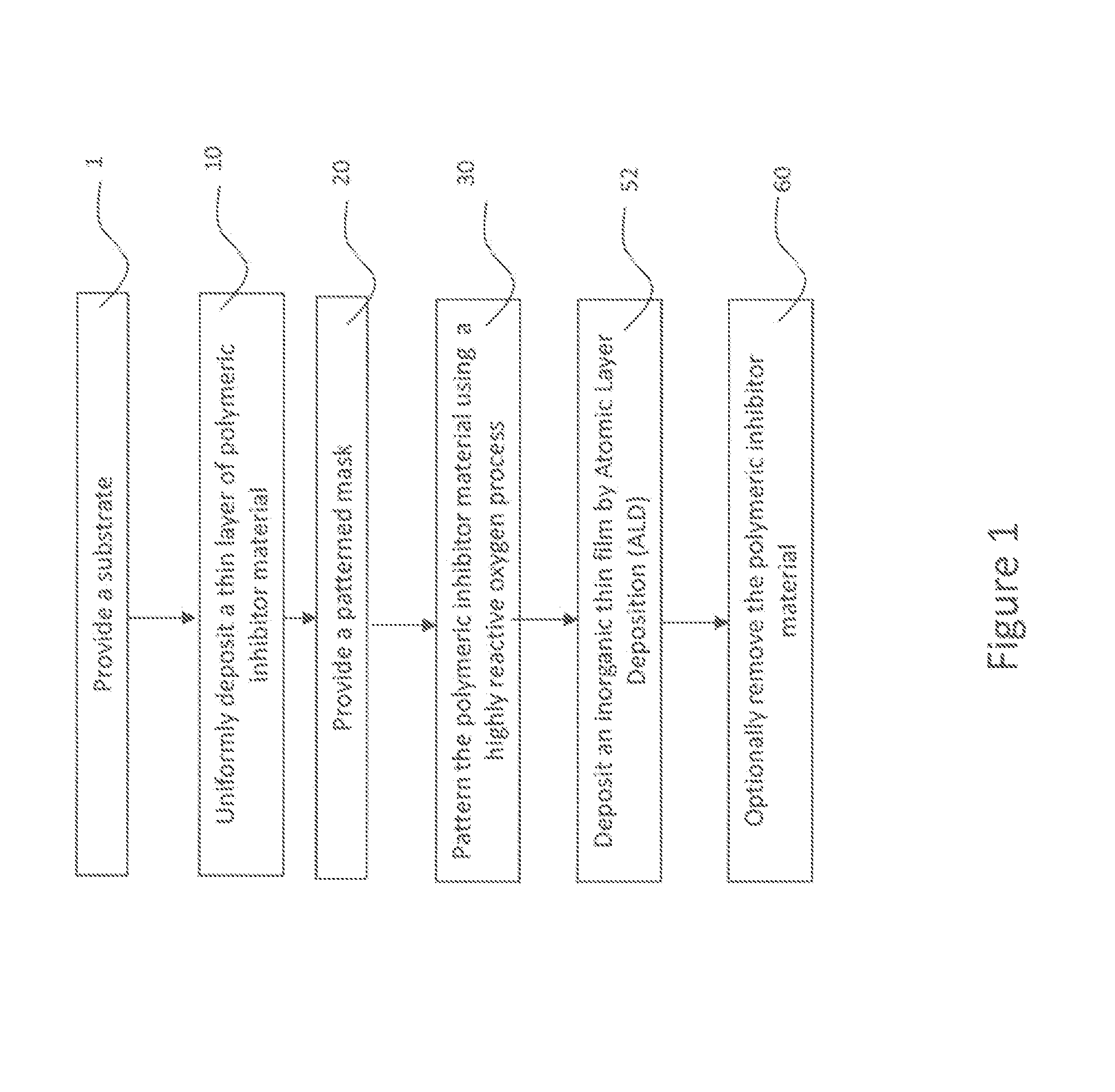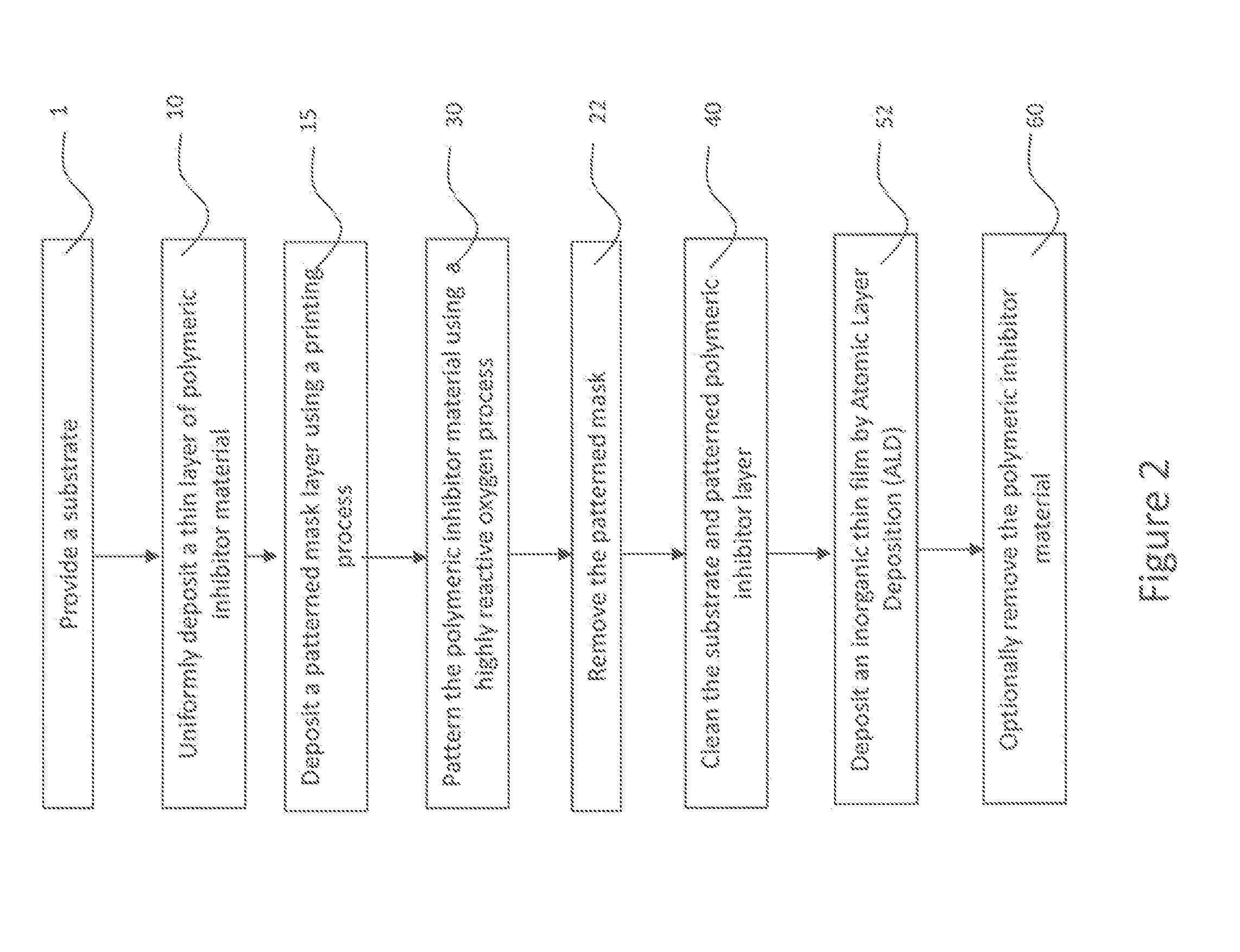Patterning for selective area deposition
- Summary
- Abstract
- Description
- Claims
- Application Information
AI Technical Summary
Benefits of technology
Problems solved by technology
Method used
Image
Examples
examples
Description of the Coating Apparatus
[0094]All of the following thin film examples employ a flow setup as indicated in FIG. 28. The flow setup is supplied with nitrogen gas flow 81 that has been purified to remove oxygen and water contamination to below 1 ppm. The gas is diverted by a manifold to several flow meters which control flows of purge gases and of gases diverted through bubblers to select the reactive precursors. In addition to the nitrogen supply, air flow 90 is also delivered to the apparatus. The air is pretreated to remove moisture.
[0095]The following flows are delivered to the ALD coating apparatus: metal (zinc) precursor flow 92 containing metal precursors diluted in nitrogen gas; oxidizer-containing flow 93 containing non-metal precursors or oxidizers diluted in nitrogen gas; and nitrogen purge flow 95 composed only of the inert gas. The composition and flows of these streams are controlled as described below.
[0096]Gas bubbler 83 contains liquid dimethylaluminum isop...
example i1
Inventive Example I1
PMMA 950
[0116]Inventive example I1, was prepared as comparative example C1 with the following exception. Instead of coating PVP k80 as the inhibitor layer, a 0.5 wt % solution of PMMA 950 in anisole was used. The sample was completed and inspected as in comparative example C1 results can be found in Table 2.
TABLE 2NominalAble toInhibitorInhibitor LayerPatterned byDirect 1100 ÅSamplematerialThickness (Å)15 min UVOof ZnOC1PVP k80160YesNoC2PVP k30160YesNoI1PMMA 950160YesYes
[0117]As can be seen in Table 2, all samples could be patterned using UVO to remove the polymer inhibitor. However, the inventive samples of PMMA retained its ability to direct the ALD growth while comparative examples C1 and C2 lost their ability to inhibit due to exposure to UVO.
Printed Masks for UV-Ozone Exposure Patterning
[0118]In order determine to printed masks would be useful to pattern polymeric inhibitors, a number of experiments were run. A detailed description of the samples and their r...
example i2
Inventive Example I2
PMMA 950 Using an Inkjet Dye-Base Ink Patterned Mask
[0119]Inventive example I2, was prepared as inventive example I1 with the following exceptions. After baking the PMMA at 180 C, ½ the sample was covered with a black dye-based inkjet in (Prosper S-series 6080020-01). The sample was then exposed to 15 minutes of UVO as in inventive example I1. After the UVO treatment, the sample was rinsed with DI water to remove the ink, and subjected to a 3 minute UVO treatment to refresh the surface. The thickness of the PMMA was measured via elipsometry after each step, and the results can be found in Table 3.
Inventive Example I3
PMMA 950 Using an Inkjet Pigment-Base Ink Patterned Mask
[0120]Inventive example I3, was prepared as inventive example I2 with the following exception. Instead of using a dye-based ink to as a mask, a pigmented black ink was used (Prosper K 11007). The sample was then completed and measured like I2, and the results can be found in Table 3.
Inventive Exa...
PUM
| Property | Measurement | Unit |
|---|---|---|
| Solubility (mass) | aaaaa | aaaaa |
| Molecular weight | aaaaa | aaaaa |
| Area | aaaaa | aaaaa |
Abstract
Description
Claims
Application Information
 Login to view more
Login to view more - R&D Engineer
- R&D Manager
- IP Professional
- Industry Leading Data Capabilities
- Powerful AI technology
- Patent DNA Extraction
Browse by: Latest US Patents, China's latest patents, Technical Efficacy Thesaurus, Application Domain, Technology Topic.
© 2024 PatSnap. All rights reserved.Legal|Privacy policy|Modern Slavery Act Transparency Statement|Sitemap



